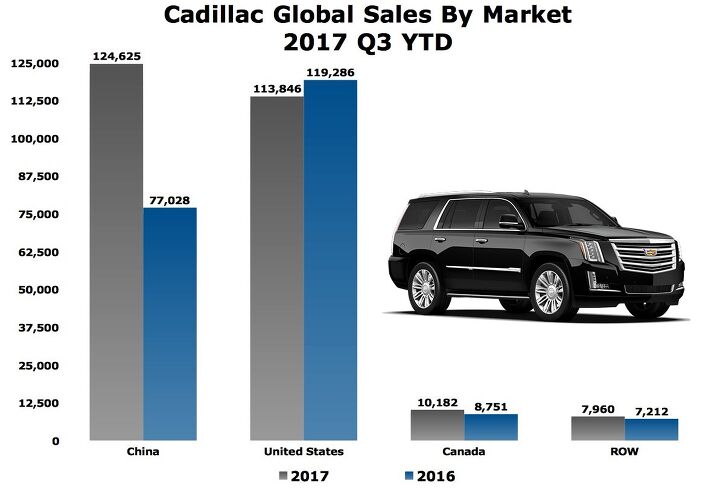That Brief Spell in Which America Was Cadillac's Biggest Market Ended in September 2017
By the slimmest of margins, Cadillac’s U.S. operations put an end to China’s repeated dominance of Cadillac’s sales charts in August 2017.
But after Americans acquired two more Cadillacs than the Chinese did in August, normal order returned in September 2017. 49 percent of the Cadillacs sold around the world last month were delivered in China, where volume rose 38 percent, year-over-year.
Perhaps of greater consequence to Cadillac’s New York HQ is the fact that September sales not only increased in China but also in the U.S., Canada, and in its rest-of-the-world markets.
September was the 16th consecutive month of global Cadillac sales improvement. Naturally much of the credit belongs to the Cadillac XT5.
Of course, Cadillac remains an exceptionally low-volume automotive brand, not just by the standards of Ford or Toyota or Chevrolet, but even compared with top-tier luxury marques. Cadillac’s global volume soared in September 2017 to 35,020 units.
By comparison, Mercedes-Benz sold 36,559 vehicles (excluding commercial vans) in the U.S. and Canada alone, another 100,000+ in Europe, and 51,127 in China. The E-Class, on its own, accounts for nearly as much global volume as the entire Cadillac brand. Mercedes-Benz’s SUVs produced more than twice as many global sales in September as the whole Cadillac brand. Moreover, Cadillac’s global streak of improvement pales in comparison to Mercedes-Benz, where global records have been broken in 55 consecutive months.
Part of the reason for Cadillac’s comparative global weakness is its dearth of passenger car demand. 40 percent of the brand’s global volume stems from the XT5. In the U.S., two-thirds of Cadillac’s sales come from the SUV/crossover department. Meanwhile, Cadillac’s U.S. passenger car volume plunged by nearly a quarter through the first nine months of 2017, a loss of nearly 12,000 sales for the brand. As a result, despite the 9-percent uptick in utility vehicle sales, total U.S. Cadillac volume is down 5 percent this year, slowing at more than twice the rate of the overall industry.
But China is providing the necessary boost to inflate Cadillac’s numbers and confidence. Cadillac’s 38-percent China improvement equalled 4,709 additional sales — for 17,248 in total — last month, driving the brand’s volume up to 124,625 through the first three-quarters of 2017.
While the U.S. has lost 5,440 Cadillac sales so far this year, China has added nearly 48,000.
[Images: Cadillac; Chart: The Truth About Cars]
Timothy Cain is a contributing analyst at The Truth About Cars and Autofocus.ca and the founder and former editor of GoodCarBadCar.net. Follow on Twitter @timcaincars and Instagram.
More by Timothy Cain
Latest Car Reviews
Read moreLatest Product Reviews
Read moreRecent Comments
- JMII Hyundai Santa Cruz, which doesn't do "truck" things as well as the Maverick does.How so? I see this repeated often with no reference to exactly what it does better.As a Santa Cruz owner the only things the Mav does better is price on lower trims and fuel economy with the hybrid. The Mav's bed is a bit bigger but only when the SC has the roll-top bed cover, without this they are the same size. The Mav has an off road package and a towing package the SC lacks but these are just some parts differences. And even with the tow package the Hyundai is rated to tow 1,000lbs more then the Ford. The SC now has XRT trim that beefs up the looks if your into the off-roader vibe. As both vehicles are soft-roaders neither are rock crawling just because of some extra bits Ford tacked on.I'm still loving my SC (at 9k in mileage). I don't see any advantages to the Ford when you are looking at the medium to top end trims of both vehicles. If you want to save money and gas then the Ford becomes the right choice. You will get a cheaper interior but many are fine with this, especially if don't like the all touch controls on the SC. However this has been changed in the '25 models in which buttons and knobs have returned.
- Analoggrotto I'd feel proper silly staring at an LCD pretending to be real gauges.
- Gray gm should hang their wimpy logo on a strip mall next to Saul Goodman's office.
- 1995 SC No
- Analoggrotto I hope the walls of Mary Barra's office are covered in crushed velvet.




































Comments
Join the conversation
Cadillac's long road downhill began when GM got greedy and wanted more volume. (started around 1965) In so doing, they killed one of Cadillac's most endearing traits to its target market: EXCLUSIVITY. All else aside, they need to re-adopt a philosophy in which there will always be one less Cadillac built than the market demands. Master this and many of their current woes will become little more than fodder for car blogs. Their profit-per-unit will be the envy of the industry. If in the process they actually become a builder of great vehicles again, that will be a plus. But exclusivity is that important to the buyers Cadillac should be wishing to attract. They can't build enough coffee bars to overcome this one issue...create desire by creating exclusivity.
While their numbers may pale in comparison to the luxury rivals, I'd point out that growth is growth. Hate all you will about history and where things went wrong as a brand, but they're now moving more metal outside of where they are home team, and selling more year over year. They've been building better cars, and the dark days are being put further and further behind them. If they continue making in roads into markets which are actively growing, that's moving in the right direction.